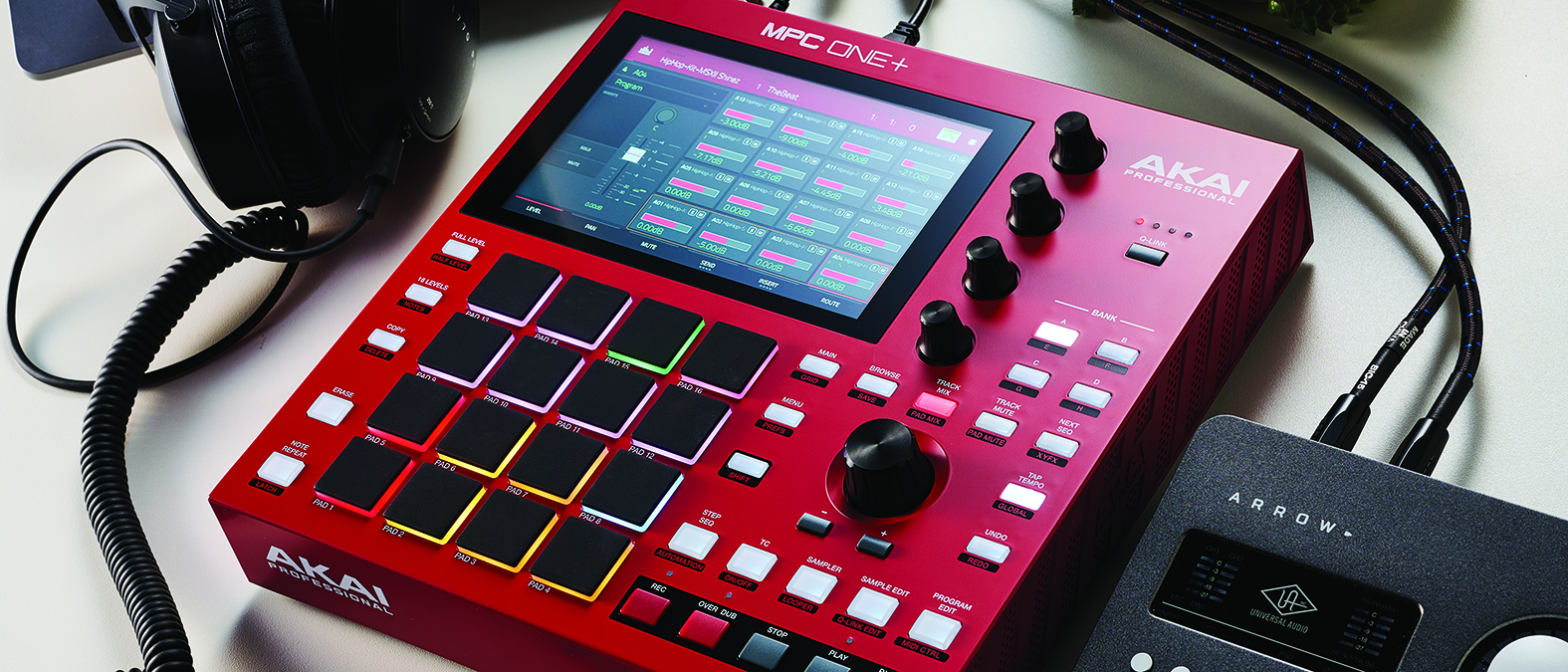MusicRadar Verdict
A minor but effective update to the original; wireless connectivity means fewer cables, always a good thing. And the colour? We like it.
Pros
- +
WiFi, Ableton Link support and Bluetooth for wireless MIDI controllers.
- +
Works standalone, or combined with other hardware/software.
- +
External class-compliant USB audio interfaces can be added to expand I/O connectivity.
Cons
- -
Despite the upgrade to 16GB, the onboard storage still feels limited.
- -
We’d really like an onboard guitar/microphone input, and a full size 1/4” headphone jack.
MusicRadar's got your back
Akai Pro MPC One+: What is it?
Having used Akai’s MPC Live (Mks 1 and 2), MPC Keys 61, and flagship MPC X SE, the mysteries of the smallest MPC, the One, have eluded us until now. It’s time to put that right, as Akai releases the upgraded MPC One+, which adds WiFi and Bluetooth, 16GB onboard storage, and of course the red finish.
The package contains the MPC One+, a power supply, a USB cable, a printed introduction sheet, and software bundle download details. Out of the box, the One+ is as red as could be, it’s a strong statement, and if nothing else it separates it from previous black and grey iterations.
The top panel features the trademark 16 MPC pads with eight banks, a 7” multi-touch display, four Q-Link knobs, a large rotary encoder, and dedicated function buttons.
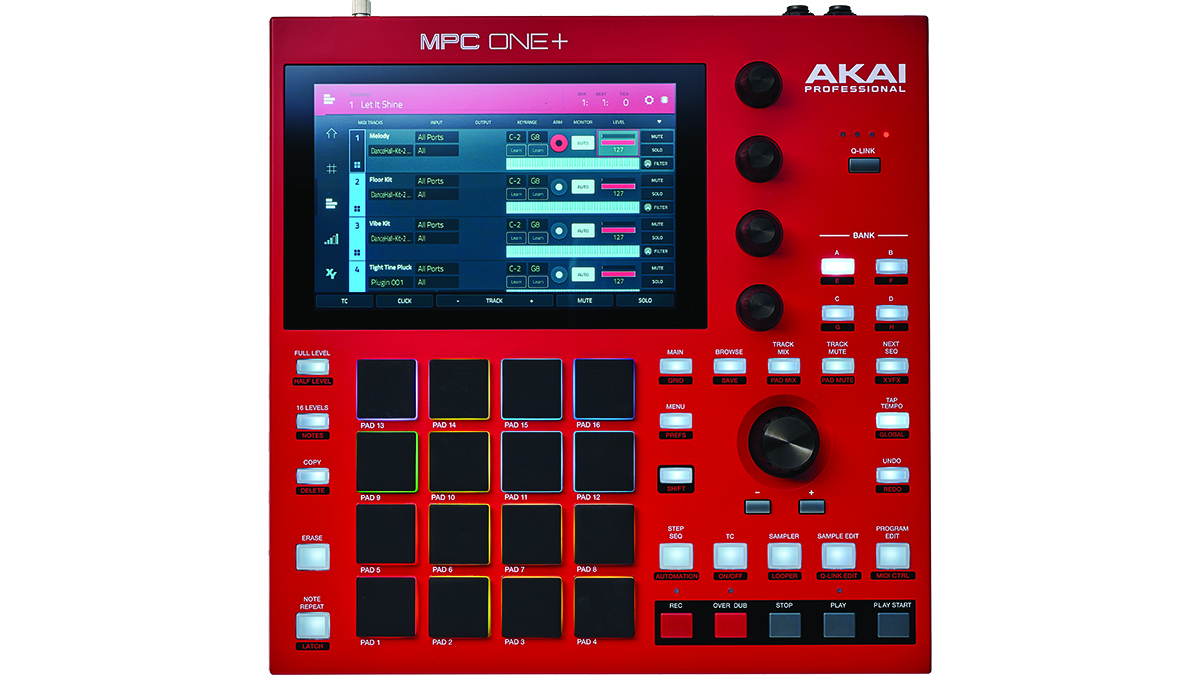
The rear panel features a master volume knob, main output 1/2 on 1/4” jacks, main inputs 1/2 on 1/4” jacks, a record volume knob, four cv/gate jacks, full-size MIDI in/out, Kensington lock slot, USB A and B ports, mains power supply socket and on/off switch. It doesn’t have dedicated microphone or guitar inputs – for those you’ll need a preamp, or the USB audio interface expansion. The front includes 1/8” headphone jack and SD card slot (there’s no option to install a hard drive, although there is more than 2GB of sample content stored internally).
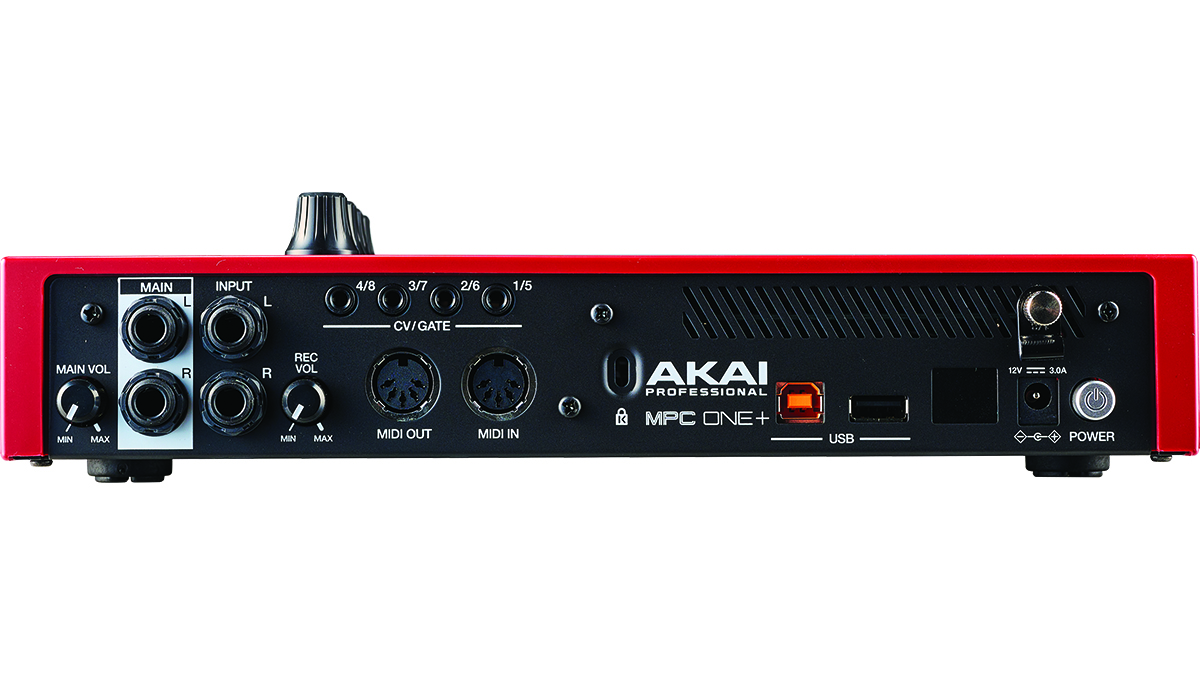
Akai Pro MPC One+: Performance and verdict
The MPC One+ arrived ready to play, and usefully, thanks to the WiFi capability, you’re prompted about available updates. We had an OS update (2.12.1) with plugin instruments to download, and demos to authorise. Splice account holders can sign in and access their material as well. This is a much smoother process than having to go back and forth with a computer connected. We needed an SD card to accommodate the instrument content.
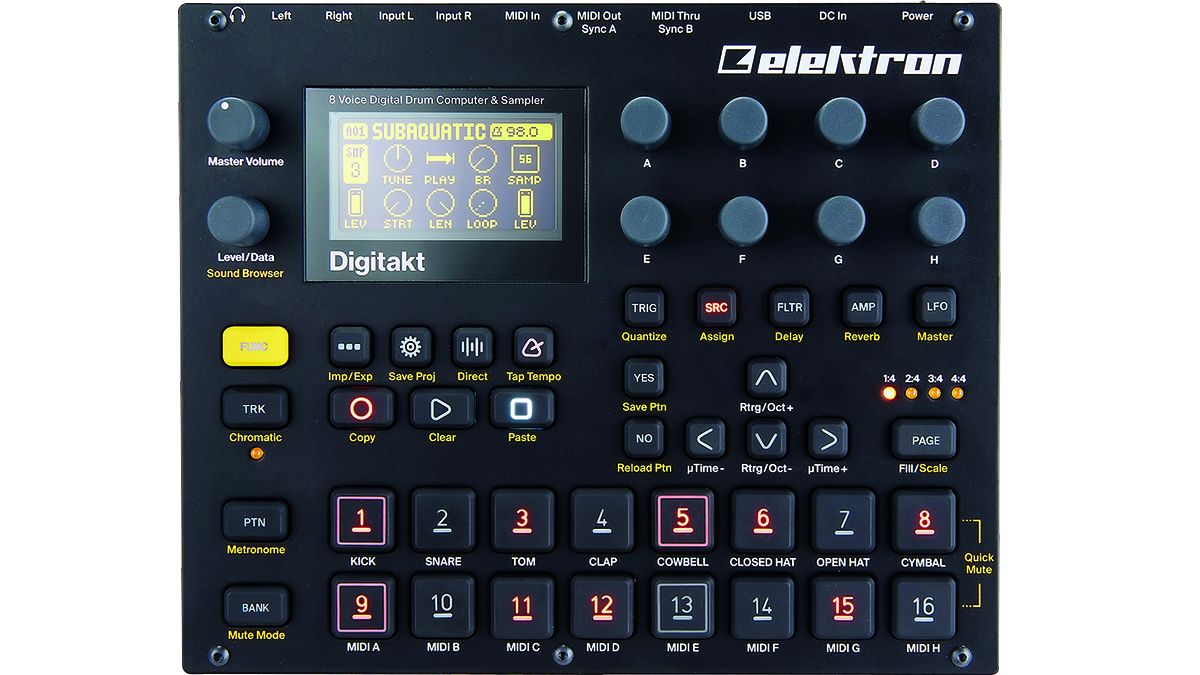
• Elektron Digitakt
This 8-track sampling drum machine and sequencer lets you sequence external gear, filters, LFOs, or apply audio effects to external inputs.
• NI Maschine Mk 3
NI’s take on sampling and sequencing functions as a 96 kHz/24-bit audio interface and controller for the computer.
• Roland SP-404 Mk II
The latest in the line of popular SP-series samplers, the SP-404 Mk II includes an OLED display, updated pads and knobs, expanded effects. Also includes 16GB of internal storage.
The MPCs share a common operating system, so we’re not going to go into too much depth with that aspect here, it’s been covered already. But the bare bones are that they all give you sampling, looping, 128 tracks of MIDI sequencing, and eight audio tracks. The sequencing can take the form of grid-based note entry, or a step sequencer, which might be cool for live performance, alongside the endlessly fun XYFX.
Samples can be used to create instrument patches called keygroups, and there’s a selection of instrument plugins included, featuring Bassline, Hype, Mellotron, and DrumSynth. Further instruments are available to purchase and download direct to the One+, and of course there are numerous audio effects.
Want all the hottest music and gear news, reviews, deals, features and more, direct to your inbox? Sign up here.
A typical workflow might begin with loading a drum kit, and creating a beat, using a combination of drawing notes in grid mode, and recording in real time, followed by adding effects to individual pads in the kit, or across the entire kit. Then you might load one or two instrument plugins and program or record some MIDI parts, using either the pads or a MIDI keyboard.
16 small pads might not seem like the best way to enter instrument parts, but they’re to the usual MPC standard, and there’s always Pad Perform Mode, where each pad triggers a chord, and handy progressions can be played with one finger, while referring to the info on the display. This is a simple and effective way to add musicality to basic beats. Once a few patterns have been created, they can be chained together to form a song, and finally mixed down to a stereo file, or the project can be sent to MPC Studio on the computer for more work.
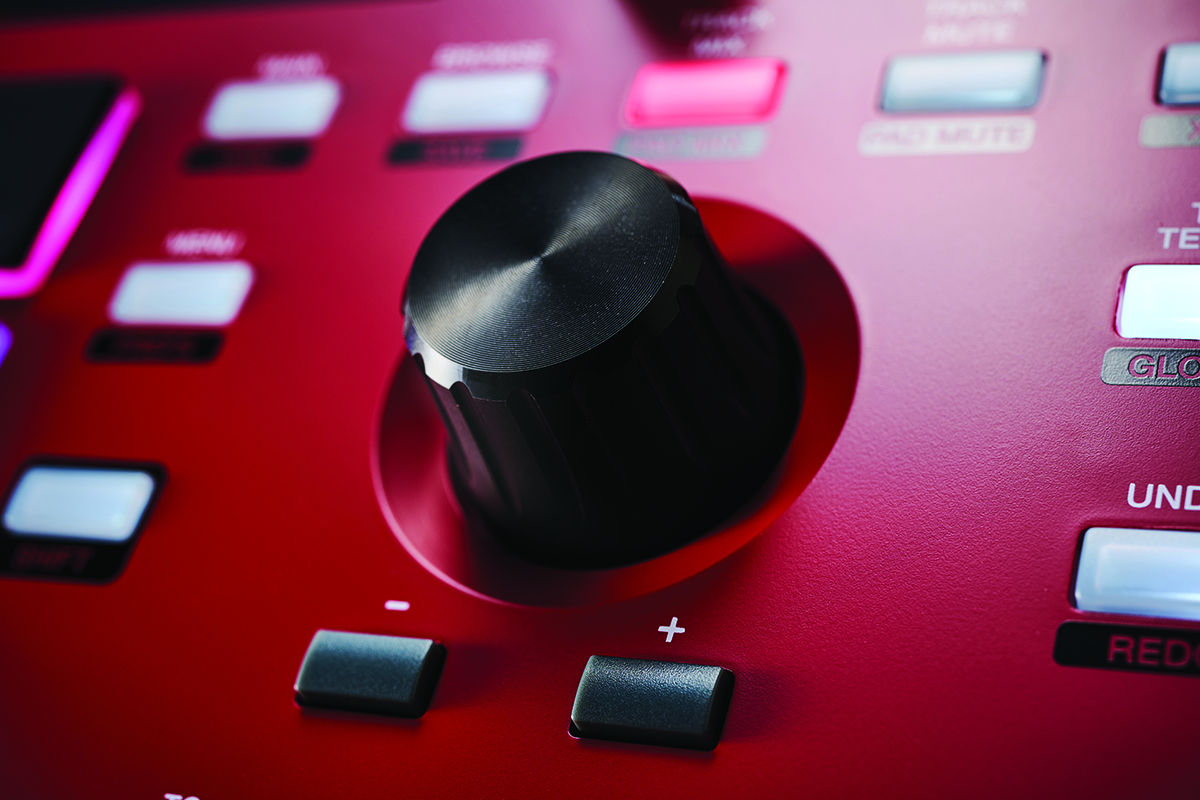
Beyond our test project, we used Ableton Link to wirelessly sync the One+ with Logic Pro for iPad, and Ableton Live 11 on macOS; this is a refreshingly simple way to get devices locked in together. In the absence of a hardware mixer, we routed the audio from the linked device back through the One+. At this point, we realised we’d like more inputs, and successfully connected the Audient EVO8 USB interface to give us four inputs (four in total, you can’t use the onboard I/O at the same time). Up to 32 inputs and outputs are available over USB, but check for compatibility before purchasing specific devices.

Hardware talking to software
Standalone music production credentials aside, you can also integrate it with your favourite software on macOS or Windows. The MPC One+ includes a licence for Akai’s own DAW: MPC Studio 2.0. This software lets you keep working with projects originated on the One+. If the hardware is connected to the computer, it can be used as a control interface as well. Alternately, projects can be originated in MPC Studio and moved to the One+, perhaps for gigs. If you prefer Ableton Live, the One+ can export to Ableton Live projects, which can be continued on the computer, and also function as a MIDI controller for Live’s Session View, mixer, and devices.

Verdict
The One+ is easy to get going with, especially for those who know the MPC workflow already. If you live to make beats, an MPC is always a good choice, but the One+ can take you to other realms too. That said, despite the enhancements, the One+ probably isn’t a worthwhile upgrade for current One owners… unless you really, really, like the colour.
It’s the entry-level MPC, but quite capable of producing complete pieces of music
The One+ is supposedly the entry-level MPC, but it’s quite capable of producing complete pieces of music. We spent most of our time treating it as a sample-based drum machine, with a few instrumental frills on top. In terms of the ‘+’ update, the most useful element is the wireless connectivity. Having now used all of the current MPCs, we’d say that this may not be the most fully-featured in hardware terms, but it’s one of the most fun to use.
MusicRadar verdict: A minor but effective update to the original; wireless connectivity means fewer cables, always a good thing. And the colour? We like it.
Akai Pro MPC One+: Hands-on demos
AkaiProVideo
Andertons Synths, Keys and Tech
gnarly.music
Sweetwater
Akai Pro MPC One+: Specifications
- I/O: 16 velocity/pressure-sensitive RGB backlit pads with eight banks, four 360º touch-sensitive Q-Link knobs, large data encoder, 31 function buttons, 7” diagonal multitouch display, multicore ARM processor, 2GB RAM, 16GB storage, SD card storage, Wi-Fi, Bluetooth, Ableton Link, class-compliant USB audio interface compatibility.
- CONTACT: Akai

Martin Delaney was one of the UK’s first Ableton Certified Trainers. He’s taught Ableton Live (and Logic Pro) to every type of student, ranging from school kids to psychiatric patients to DJs and composers. In 2004 he designed the Kenton Killamix Mini MIDI controller, which has been used by Underworld, Carl Craig, and others. He’s written four books and many magazine reviews, tutorials, and interviews, on the subject of music technology. Martin has his own ambient music project, and plays bass for The Witch Of Brussels.
